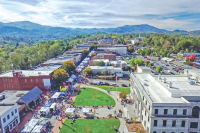Haywood’s economic path was set early last century
 The rapid pace of change these days often leaves many of us feeling helpless in its wake. Things change, then change some more, and finally a transformation so complete has taken place that very little of what we started with is familiar.
The rapid pace of change these days often leaves many of us feeling helpless in its wake. Things change, then change some more, and finally a transformation so complete has taken place that very little of what we started with is familiar.
Think the music industry, or what the phone in your pocket will do. Crazy stuff.
But every now and again, one can look around and note things that haven’t changed that much. In some cases that is very reassuring; other times it’s scary.
A couple of months ago I was honored when members of the Live and Learn group at Lake Junaluska asked if I’d be their guest and deliver a talk. With a two-month window to prepare something, I started thinking about Haywood County’s economy and where it might be heading.
While doing some research, I was reminded of something that a Haywood local pointed out to me almost 20 years ago — the county’s economy was set on its current course during a 30-year period in the early 1900s, and very little has changed in the nearly 100 years since. Well, I’m not sure I agree about “little” changing in the subsequent century, but in many ways he was right.
So what happened 100 years ago?
Related Items
Champion International
In 1908, Champion Paper opened in Canton. Perhaps no single event has had a more significant, direct impact on Haywood County. It gave rural mountain men and women jobs. It gave them money to purchase household goods and homes in town. The sons and daughters of these mill workers went to college and came back here as teachers, accountants, lawyers and doctors. And that ripple effect is still occurring today.
At its peak, Champion employed well over 2,000 people, and today Evergreen Packaging still has about 1,200 workers at its plants in Canton and Waynesville.
The paper mill helped propel Haywood County’s growth as an industrial and manufacturing powerhouse. In addition to Champion, by the 1950s and 60s in Hazelwood there was Dayco Rubber, Lee industries (a furniture plant), Wellco (a shoe factory), a tannery and a chemical factory. Haywood was still very rural, but it also had a growing middle class of workers. In some ways Haywood was more like communities in the Midwest or Northeast due to this group of manufacturers. We had influence in Raleigh at the General Assembly, which helped lead to state infrastructure projects like the construction of Interstate 40 here rather than somewhere else.
Today, news entities are constantly reporting about the loss of U.S. manufacturing jobs. That did happen for the first few years after the 2008 recession, but today the facts don’t bear that out. As the economy has recovered, the truth is the country and this region are adding manufacturing jobs. Both Sonoco (a maker of plastic food trays from its Howell Mill Road plant) and ConMet (a maker of foam rubber dashboards for big rigs from its Canton plant) have added workers over the last few years. During 2012, Haywood added 387 manufacturing jobs.
Lake Junaluska, tourism
Lake Junaluska Assembly opened in 1908. Perhaps it’s not a coincidence that the paper mill and Junaluska Assembly were under construction and being created at the same time. The Appalachians were still an unexplored wilderness, a place where those with dreams and vision could make their mark.
Lake Junaluska was one of the early mainstays of an already burgeoning tourism industry in Haywood and today attracts nearly 250,000 visitors a year. Methodists and their families visited the mountains for spiritual enrichment, and many bought homes. Children who spent summers here came back to live.
Perhaps just as important when talking about Lake Junaluska is its cultural and civic legacy. I have no doubt that the intellectual life of this community has been more enriched by this religious center than anyone will ever be able to quantify. Whether it’s Jimmy Carter coming to the peace conferences or Elizabeth and Bob Dole just popping in our newspaper office when she was running for Senate — Elizabeth Dole spent time as a youth at Lake Junaluska — it has brought so many ideas and progressive people to Haywood County that its impact both economically and culturally is greater than most give it credit for.
And now that the Lake is trying to position itself as both a conference center and still remain a religious center, its impact on the Haywood tourism industry will increase.
The Smokies, the Parkway
The third event that happened in the first part of the 1900s was the creation of the Great Smoky Mountains National Park and the construction of the Blue Ridge Parkway. These two national park units — along with the Pisgah and Nantahala national forests — have become the anchors of our tourism industry.
As many know, the Canton paper mill was a catalyst for the massive logging operations that began to proliferate in this region in the early 1900s. That destruction of the wilderness galvanized socially conscious citizens to begin efforts to preserve what was left. And that led to the eventual creation of the Great Smoky Mountains National Park in 1937.
The Blue Ridge Parkway came soon after that, and both of them started bringing in hordes of tourists as the automobile became a staple of life in this country.
The same, only different
So even today, Haywood is still dependant economically on these events that happened in the early part of the last century. But I think that puts Haywood in a good place. Tourism and seasonal residents are taking on a more important role in the economy, and that won’t change. With a still-formidable manufacturing base, that brings diversity many mountain counties envy.
While Haywood has to find ways to keep these older industries strong and updated, it should benefit from its neighbors: Asheville and its still-soaring popularity to the east and the ever-growing, sizzling growth at Harrah’s and Cherokee to its west.
All things change, but Haywood is still better economically than most mountain counties its size.
(Scott McLeod can be reached at This email address is being protected from spambots. You need JavaScript enabled to view it..)









